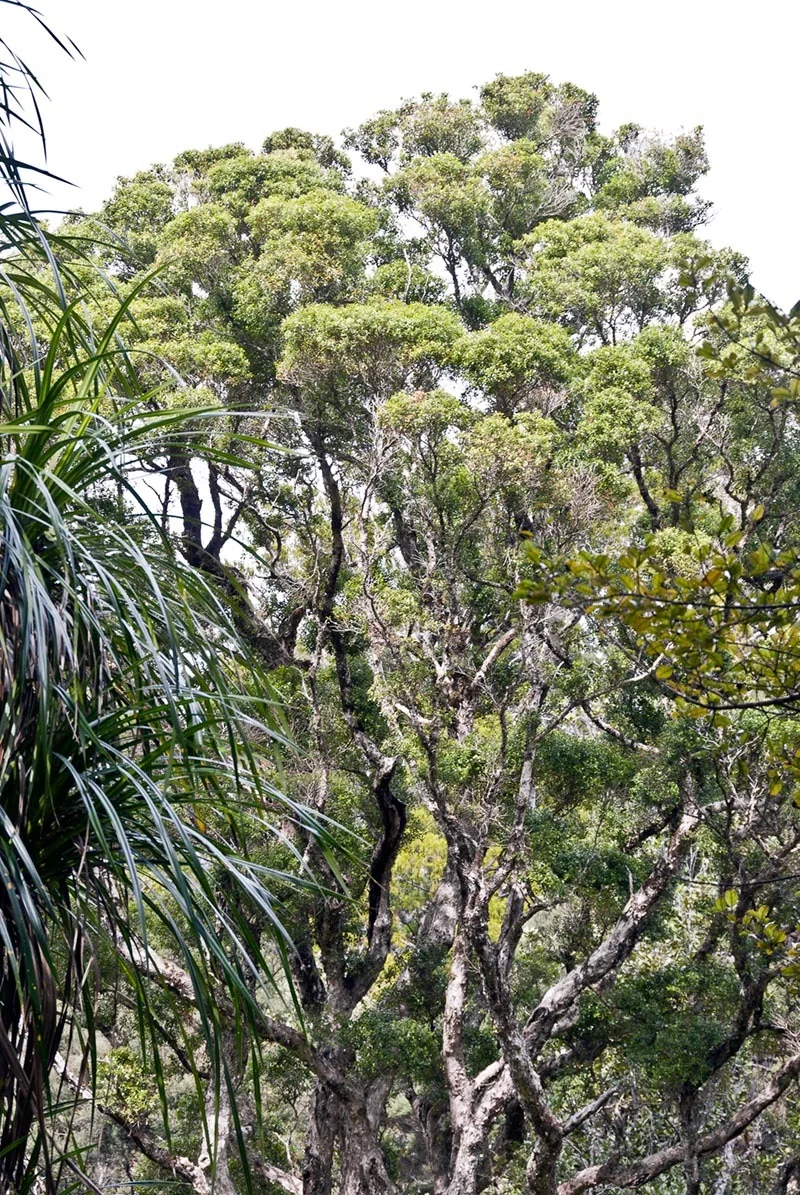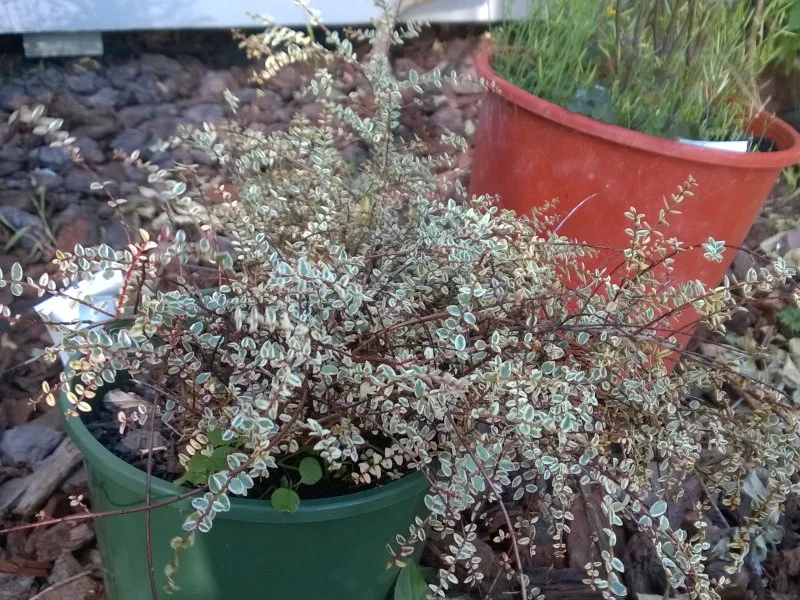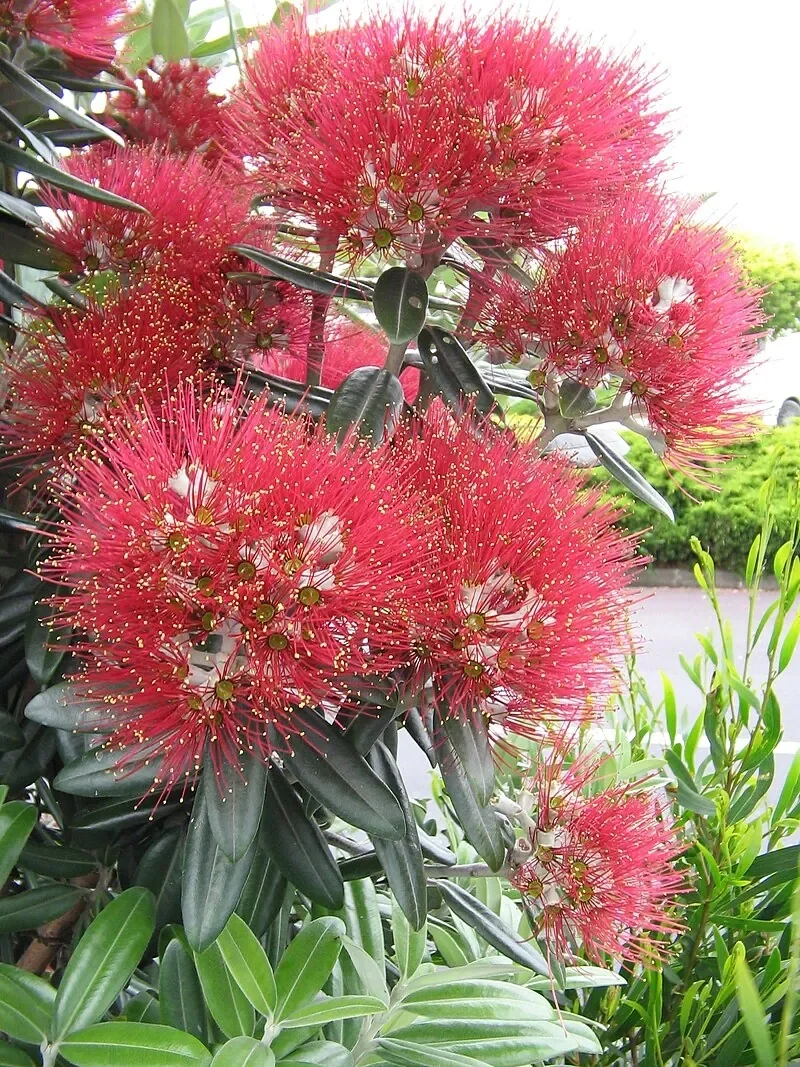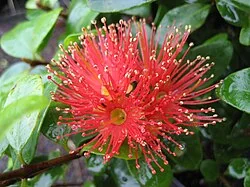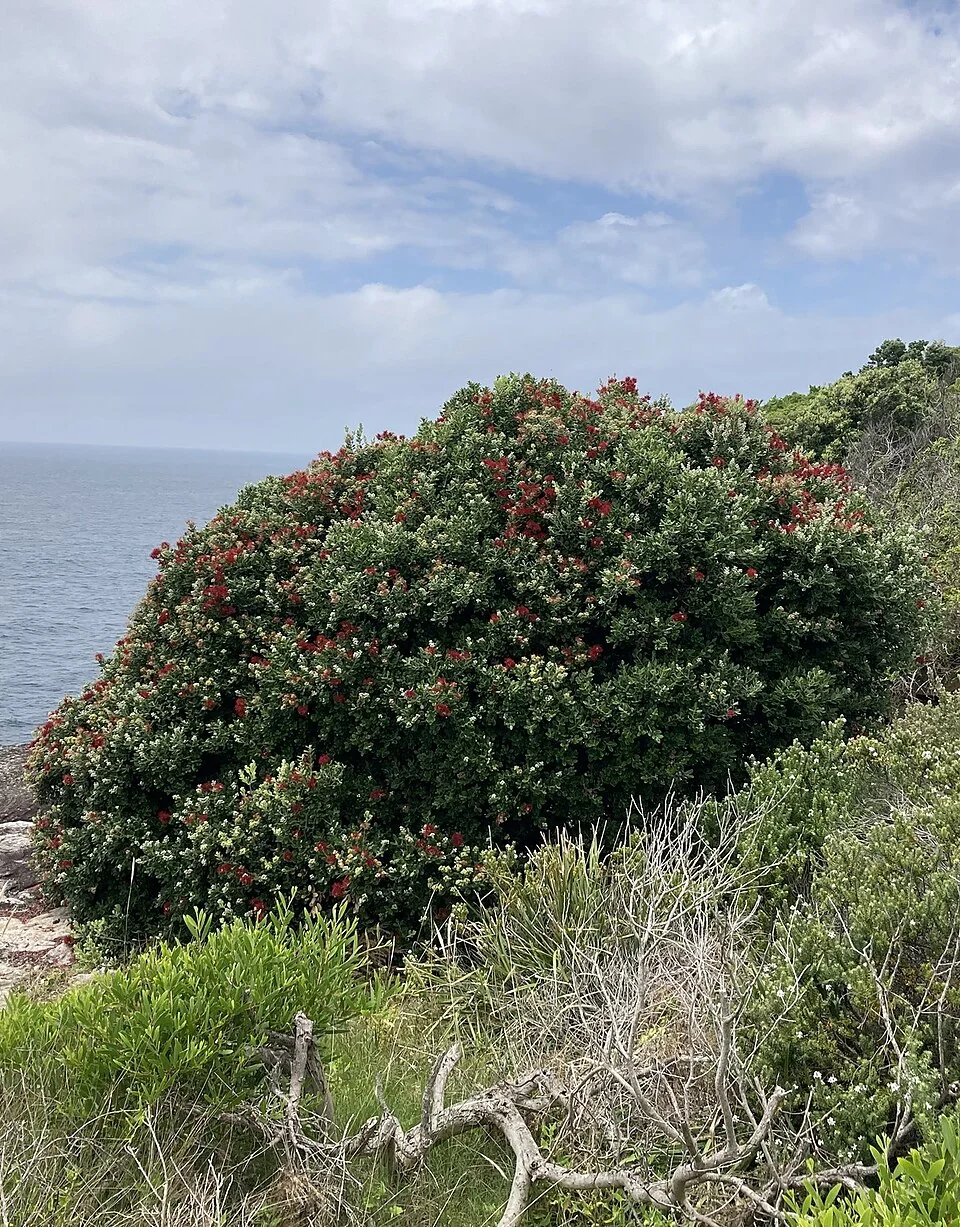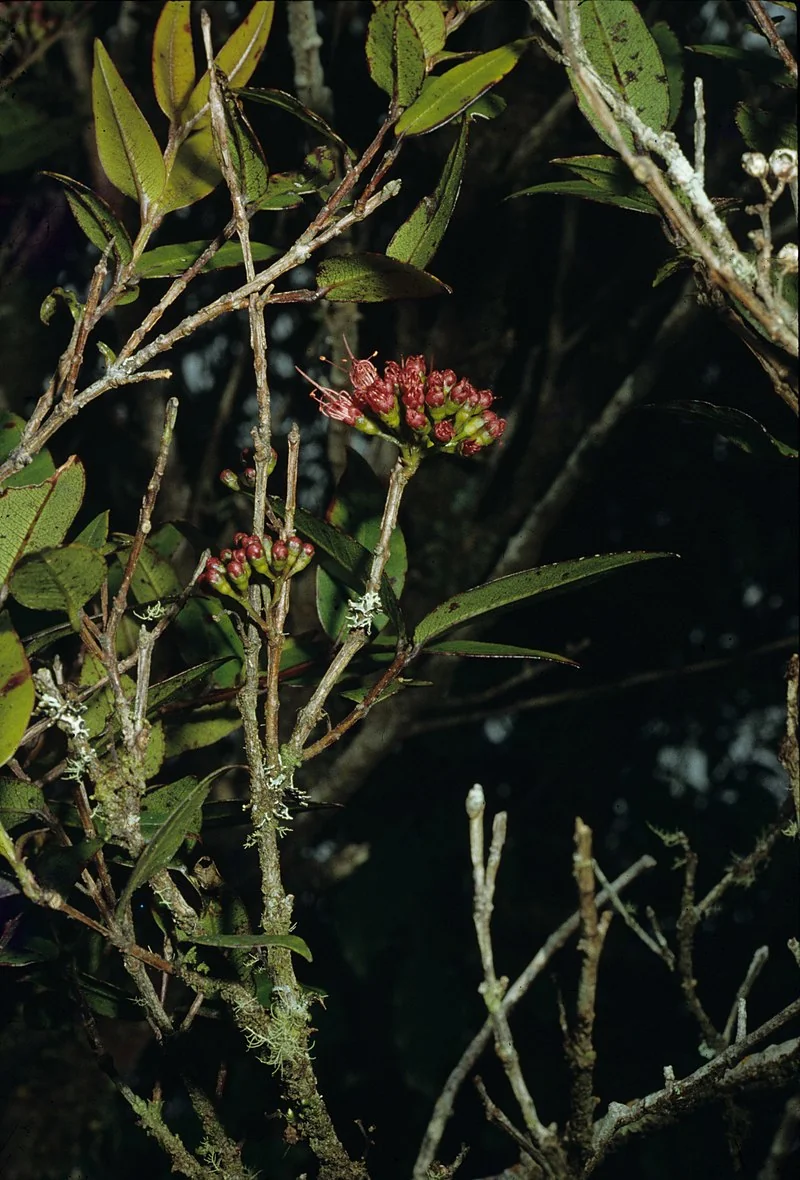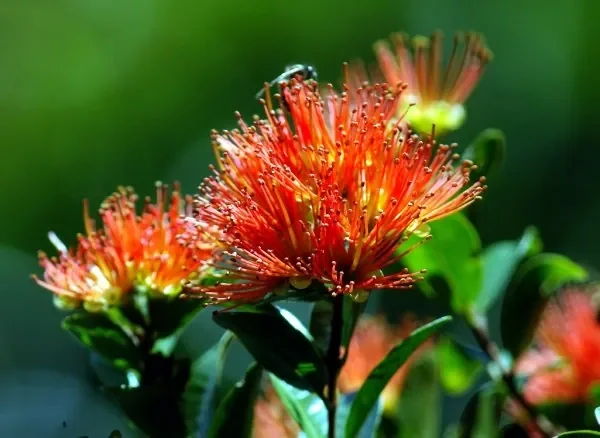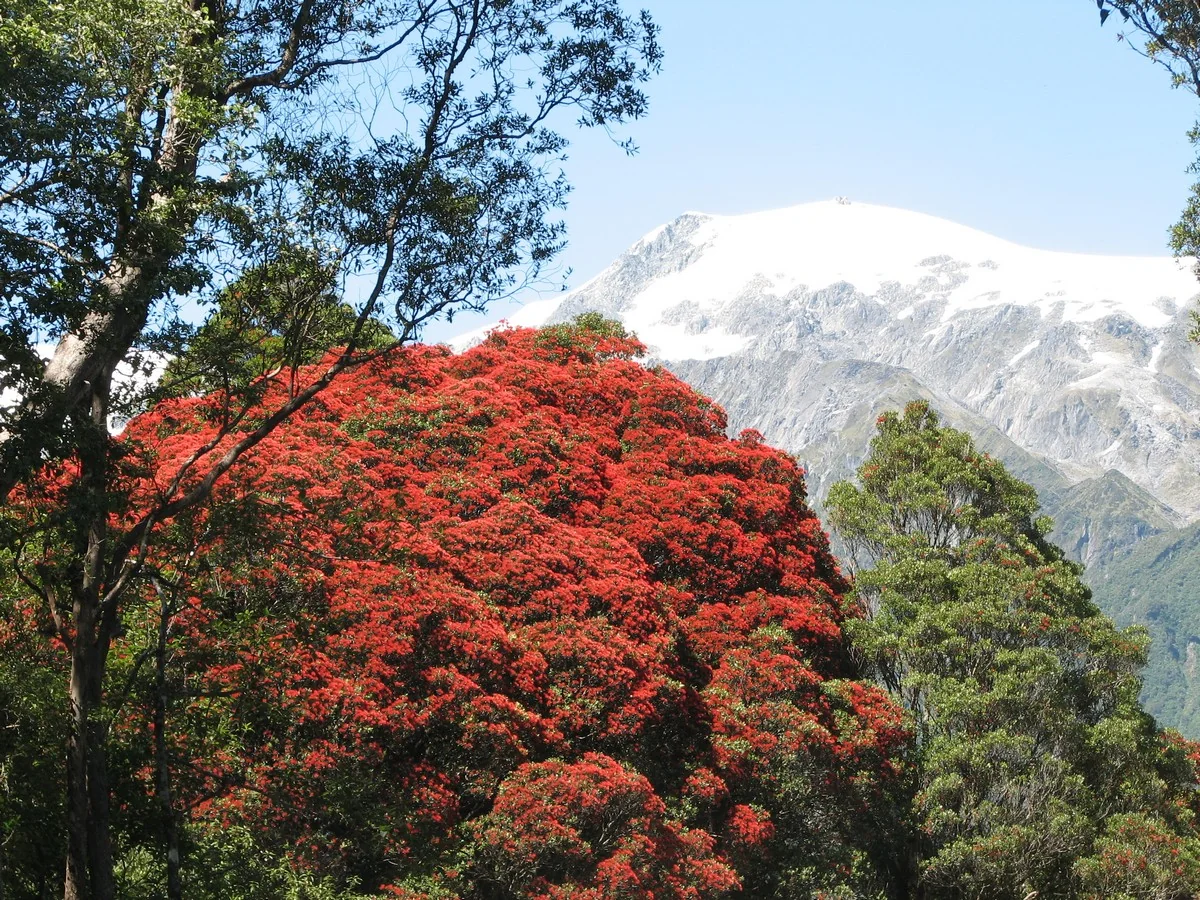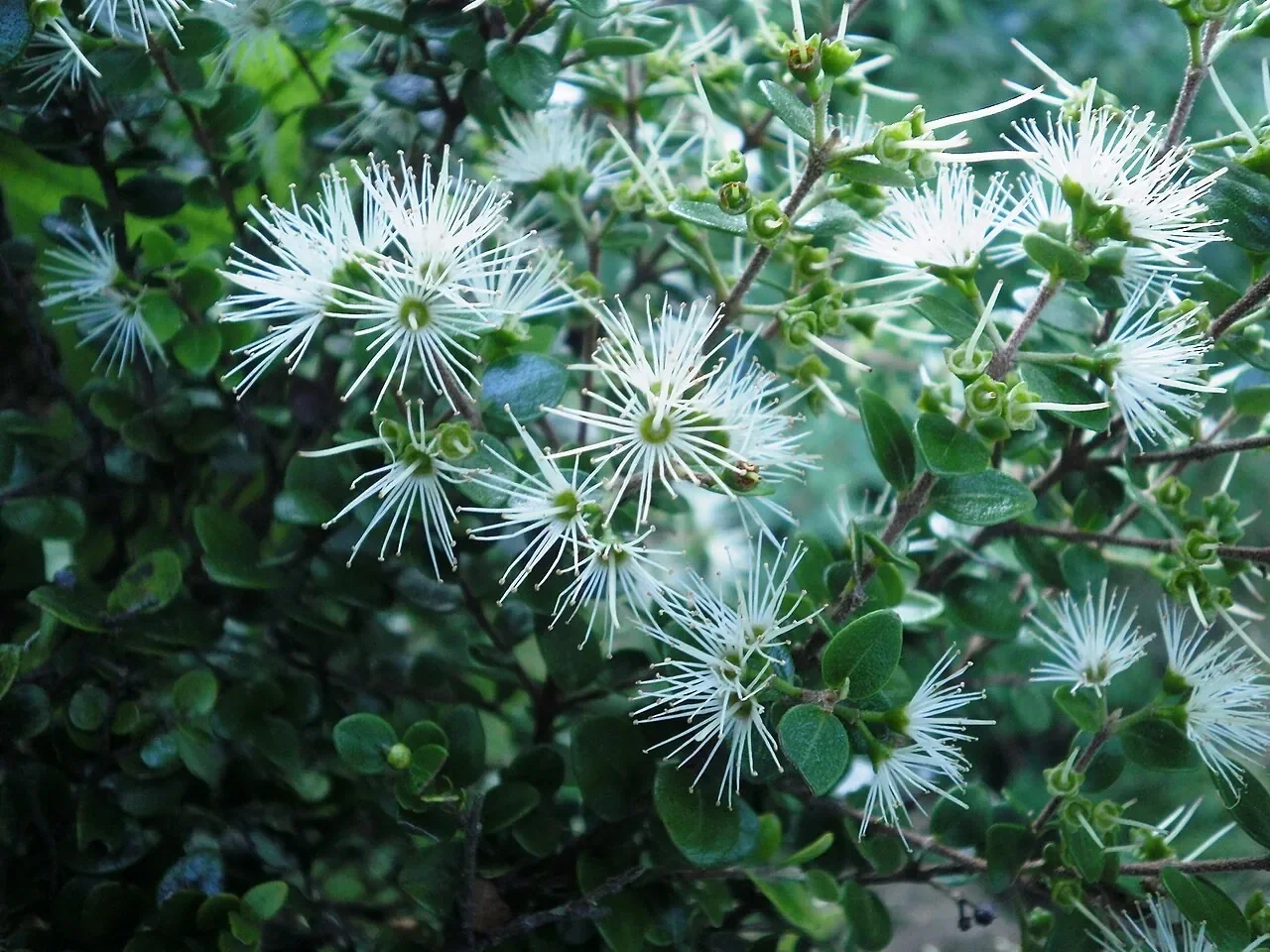
White Rātā
Metrosideros perforata
Introduction
About White Rātā
Metrosideros perforata , commonly known as White Rātā or Climbing Rātā, is a distinctive native vine that begins life as an epiphyte high in the forest canopy before sending down impressive aerial roots to eventually become a powerful strangling climber. This remarkable plant produces clusters of white to cream bottlebrush flowers with prominent red stamens, creating spectacular displays that attract tūī, bellbirds, and numerous native insects. Found naturally in lowland to montane forests throughout New Zealand, White Rātā is unfortunately now classified as Nationally Vulnerable due to habitat loss and the devastating impacts of myrtle rust disease, making conservation efforts and careful cultivation increasingly important for this iconic species. Explore more in the native plants index .

Plant Description
Botanical Features
White Rātā ( Metrosideros perforata ), also known as climbing rātā, akatea, or akatorotoro, is a woody, long-climbing vine endemic to New Zealand. It can reach up to 20 meters in length, often starting as an epiphyte before sending down aerial roots to become a powerful strangling climber. The bark is furrowed, dark grey to brown-black, somewhat tessellated, and flakes in tabular shards. The leaves are close-set, leathery, and glandular-punctate, typically 6-12 mm by 5-9 mm, broad-ovate to suborbicular, dark green above, and very pale green below. It produces dense, terminal, fluffy clusters of white (rarely pink) flowers, which are star-shaped and have numerous stamens 8-10 mm long. These flowers appear from late spring to summer and attract native birds like tūī and bellbirds, as well as various insects.
Quick Facts
Overview
| Scientific Name | Metrosideros Perforata |
|---|---|
| Height | 10-15 m (climbing) |
| Spread | 5-8 m |
| Water Needs | Moderate |
| Light | Partial shade to full sun |
| Frost Tolerance | Moderate |
| Salt Tolerance | Moderate |
| Growth Rate | Moderate |
| Lifespan | Long-lived |
Climate Best Suited to
White rātā (āki) occurs from coastal to montane forest margins. It prefers mild, well-watered climates with shelter and support trees; tolerates light frosts inland once established.
Regional Suitability
| City | Climate Suitability |
|---|---|
| Whangārei | Ideal |
| Auckland | Ideal |
| Hamilton | Ideal |
| Tauranga | Ideal |
| Rotorua | Ideal |
| Gisborne | Ideal |
| New Plymouth | Ideal |
| Napier | Ideal |
| Whanganui | Ideal |
| Palmerston North | Ideal |
| Wellington | Ideal |
| Nelson | Ideal |
| Christchurch | Ideal |
| Dunedin | Ideal |
| Invercargill | Ideal |
Natural Habitat
White Rātā is a versatile climbing vine found in a variety of habitats, from coastal to montane environments, across the North, South, and Three Kings Islands. It is commonly found in open scrub, dense forests, and on rocky outcrops. It is a vigorous climber, often seen scaling tree trunks, cliff faces, and even forming a dense "shrub-land" on loose talus slopes.
Plant Conservation
Metrosideros perforata , also known as White Rātā or Climbing Rātā, is a native New Zealand vine that faces conservation challenges primarily due to myrtle rust disease and habitat loss. In 2018, its conservation status was upgraded to 'Threatened - Nationally Vulnerable' as a precautionary measure after the detection of myrtle rust ( Austropuccinia psidii ) in New Zealand. This invasive fungus poses a significant threat to native myrtle species, including Metrosideros perforata . While its 2023 national conservation status is "Not Threatened," regional statuses vary, with Auckland classifying it as "At Risk - Regionally Declining" and Otago as "Regionally Data Deficient." The primary threats are myrtle rust and habitat loss. Myrtle rust has been detected on Metrosideros perforata , among other Metrosideros vines. Metrosideros perforata is a woody, long-climbing vine endemic to New Zealand, found in coastal to montane environments, including open scrub, dense forest, and rocky areas. Conservation efforts include careful cultivation and propagation. It can be grown from rooted pieces or semi-hardwood cuttings, though cuttings can be difficult to strike. Air layering is another, more advanced, propagation technique.
Growing Requirements
Support and Soil
Provide a sturdy support (fence, trellis, or host tree). Plant in moist, free-draining, humus-rich soils; avoid prolonged waterlogging.
- Moist, fertile loams with organic matter
- Strong support for climbing habit
Light Requirements
Best in full sun to light shade; more sun yields heavier flowering.
Water Requirements
Keep evenly moist in summer; drought slows growth and flowering.
Planting Guide
When to Plant
The best time to plant White Rātā is during the cooler months, from autumn to early spring, to allow root establishment before summer.
How to Plant
- Dig a hole twice the width and depth of the plant's root ball.
- Mix compost into your existing soil at a 50/50 ratio.
- Backfill the hole so the top of the plant's roots sits level with the surrounding ground.
- Firm the soil gently and water thoroughly.
- In heavy clay soils, plant on a raised mound and use gypsum clay breaker to improve drainage.
Care and Maintenance
- Watering: Water regularly while the plant is establishing. Once established, it thrives with consistent humidity and prefers balanced moisture, typically requiring watering every two weeks, as it has moderate drought tolerance.
- Fertilizing: Apply a balanced fertilizer every 4-6 weeks during the growing season (spring and summer) for optimal growth and flowering. Reduce fertilization in fall and withhold in winter.
- Pruning: Prune lightly after flowering to encourage dense growth and maintain shape. The best time to prune is in early spring before new growth begins. Remove dead or damaged stems and thin overcrowded areas to improve air circulation and light penetration.
Ecological Role
Akatea ( Metrosideros perforata ) threads through shrubland and forest margins, adding nectar, cover, and connectivity across multiple canopy layers.
Pollination and Food
- Nectar supply: Seasonal flowering feeds insects and nectarivorous birds, sustaining pollinator networks.
- Seed pathways: Bird movements distribute seed among wooded fragments and riparian corridors.
Habitat Structure
- Canopy stitching: Climbing stems tie shrubs and trees together, creating travel routes and shelter for small fauna.
- Epiphytic niches: Rough stems and branch junctions host bryophytes and invertebrates, enriching microhabitats.
Resilience
- Gap response: Rapid extension into openings helps re-establish cover after disturbance.
- Myrtle rust awareness: As a myrtle, benefits from diverse plantings and airflow to reduce pathogen pressure.
By fuelling pollinators and enriching canopy structure, akatea boosts biodiversity and stability in native forests.
Uses and Significance
Produces exceptionally abundant nectar during its spectacular flowering displays that provides critical food resources for tūī, korimako (bellbirds), and numerous native insects including beetles, moths, and native bees. The dense climbing growth creates valuable vertical habitat structure, offering nesting sites and shelter for small birds and invertebrates while contributing to forest biodiversity. As a keystone species in forest ecosystems, its decline threatens the complex ecological relationships it supports.
Cultural Notes
Part of the rātā/Pōhutukawa group with rich kōrero; susceptible to myrtle rust: plant in sheltered, diversified settings.
Landscaping Ideas
White Rātā for Light Structures
- Trellis and fences: Train leaders onto horizontal wires to encourage flowering along the stems.
- Evergreen screen: Intertwine with other natives to form a wildlife-friendly, flowering screen.
- Coastal mild areas: Well-suited to maritime gardens with shelter from severe frost.
Provide full sun to bright light and free-draining soil. Avoid excessive nitrogen which pushes leaf at the expense of bloom.
Seasonal Care Calendar
Spring
Feed lightly; train new shoots onto supports.
Summer
Water during dry spells; monitor for myrtle rust.
Autumn
Tidy, secure ties; reduce irrigation as growth slows.
Winter
Minimal pruning; avoid cutting flower-bearing wood.
Pruning and Maintenance
Techniques and Timing
Train main leaders early to establish strong structural framework, guiding growth onto appropriate supports while young stems are flexible. Remove congested, crossing, or weak stems after flowering to maintain good air circulation and reduce disease risk, particularly important given this species' vulnerability to myrtle rust. Avoid hard renovation cuts as these vigorous climbers can be slow to recover and may produce excessive weak regrowth that's more susceptible to pest and disease problems.
How to Grow White Rātā
White Rātā, also known as Climbing Rātā, is a distinctive native vine that begins life as an epiphyte before sending down impressive aerial roots to become a powerful strangling climber. This remarkable plant produces clusters of white to cream bottlebrush flowers, creating spectacular displays that attract native birds and insects. Found naturally in lowland to montane forests throughout New Zealand, White Rātā is unfortunately now classified as Nationally Vulnerable, making conservation efforts and careful cultivation increasingly important for this iconic species. Understanding its propagation methods is key to successfully growing this unique species.
From Seed
Propagating White Rātā from seed is a viable method, though it requires fresh, fine seeds and careful attention to conditions. Collect fine seed from mature capsules in late summer to autumn when they begin splitting naturally. Surface-sow without covering on a sterile, fine-textured propagation mix, as seed requires light for successful germination. Maintain consistent moisture and temperatures around 18-22°C, with germination typically occurring within 2-6 weeks under optimal conditions. Seedlings develop slowly and require careful protection from temperature extremes and fungal diseases during establishment. This method is crucial for maintaining genetic diversity and for large-scale restoration projects.
From Cuttings
Semi-hardwood cuttings taken from current season's growth in late summer can root successfully with rooting hormone and consistent mist propagation, though success rates vary significantly between individual plants and genetic lines. Select healthy, non-flowering shoots 10-15cm long, remove lower leaves, and treat with hormone before placing in well-draining propagation mix under high humidity conditions. This method is increasingly important for conservation propagation given the species' threatened status, as it allows for the cloning of desirable genetic material. Patience is required, as rooting can take several months.
From Air Layering
Air layering is an advanced propagation technique that can be used for White Rātā, particularly for larger specimens or when cuttings prove difficult. This method involves inducing roots to form on a stem while it is still attached to the parent plant. Select a healthy, semi-woody branch. Remove a ring of bark (about 2-3 cm wide) around the stem. Apply rooting hormone to the exposed cambium layer and wrap the area with moist sphagnum moss, then cover with plastic film to maintain humidity. Once roots have formed (which can take several months), the layered branch can be cut from the parent plant and potted. This method requires careful monitoring and is best suited for experienced propagators.
Pests and Diseases
Myrtle Family Considerations
- Myrtle rust: Inspect young flushes for yellow/orange pustules; prune for airflow and avoid clipping during humid flushes.
- Scale/sooty mould: Treat with horticultural oil; rinse foliage to restore photosynthesis.
- Leafrollers: Remove rolled leaves; encourage birds and beneficials.
- Waterlogging: Ensure containers and beds drain freely to prevent root decline.
Cultural Significance
Traditional Uses and Values
Metrosideros perforata , commonly known as White Rātā or Akatorotoro, holds cultural significance for Māori. It was historically used for lashing, including weapons and palisades. The Māori name "Akatorotoro" itself is noted in various sources.
The genus Metrosideros, to which Metrosideros perforata belongs, is part of the widespread myrtle family, which has cultural significance in Mediterranean cultures. A book titled "Pōhutukawa and Rātā: New Zealand's Iron-Hearted Trees" by Philip Simpson (2005) provides an exhaustive resource on the cultural and mythological significance of these trees.
Ecologically, Metrosideros perforata is important as it produces abundant nectar, providing a critical food source for native birds like tūī and korimako (bellbirds), as well as numerous native insects including beetles, moths, and native bees. Its dense climbing growth also creates valuable habitat, offering nesting sites and shelter for small birds and invertebrates, contributing to forest biodiversity. It is also a favored host for several native stick insects.
Bonus Tip
Expert Growing Advice
White rātā ( Metrosideros perforata ) roots readily from semi-ripe cuttings taken in late summer if given bottom heat and a free-draining, coarse mix. Keep humidity high but the medium airy to avoid losses - the fine roots dislike compaction.
